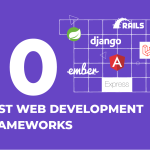The pandemic has accelerated digital transformation initiatives across all industries, highlighting the indispensable role of technology in business evolution. As companies navigated this new landscape, adapting through technology became crucial for survival. According to Statista, the enterprise software revenue is on track to be valued at over $376 billion in 2028.
JavaScript, Python, Java, and C++ are examples of the most common programming languages being used in web application development. But for companies that require high-performance, highly scalable applications, Node.js and React are quickly becoming two of the most popular (and powerful) technologies used for both web and mobile app development.
In this guide, we go in-depth on why your company should develop apps with Node and React — business advantages, technical advantages, and how you can jumpstart your organization’s app development project.
The High-Performance Tech Stack: React and Node.js

Startups, SMBs, and global enterprises alike are all leveraging the robust technical and business benefits that Node.js and React can facilitate. Below is a high-level overview of each technology, followed by the business and technical advantages of using React and Node.js for your development projects.
Node.js
Node.js is an open-source, cross-platform runtime environment for executing JavaScript code outside of a browser. It is commonly used to build back end services such as Application Programming Interfaces (APIs), which power client applications (e.g., a web app running within a web browser or a mobile app running on a mobile device).
Some of Node.js’s defining features include:
- Excellence in prototyping and agile development
- Capability to build ultra-fast and highly scalable services
- The largest ecosystem of open-source libraries available on the web
- Easy to get started
Node.js is ideal for building highly scalable, data-intensive, and real-time back end services that power client applications. Although there are numerous back end development platforms available, Node.js has emerged as one of the most popular choices. Companies ranging from lean startups all the way to large organizations such as NASA, PayPal, Uber, Netflix, and Walmart, all use Node.js in production.
How Node.js works: executive overview

- Node.js utilizes a non-blocking I/O model, which enables a singular process to serve numerous requests concurrently. When used in the proper context, a non-blocking I/O model can reduce the latency of an application, improve responsiveness, and optimize throughput.
- The technology was built on Google Chrome’s V8 JavaScript Engine, which is widely known for its fast and efficient execution of code.
React
Contrary to popular belief, React is neither a framework nor a programming language; it is a JavaScript library used by developers to create interactive, complex, and streamlined user interfaces (UIs). React’s versatility allows its use in a wide range of applications, from single-page app development and cross-platform mobile apps to complex web applications.
Some of React’s defining features include:
- A robust JavaScript library used for UIs
- Highly flexible, supporting both web and mobile apps
- Component architecture and declarative approach
- A one-way data flow, setting a standard that many JavaScript applications now follow
React was developed at Facebook and is currently the most popular JavaScript library for building complex, interactive UIs, ahead of both Angular and Vue.
Its adoption by industry leaders, including Airbnb, Twitter, Instagram, Shopify, and WhatsApp, underscores the power and popularity of React in developing innovative applications.
Let SaM Solutions’ React team handle frontend development and receive fast, responsive, and stylish interfaces for your applications.
How React works: executive overview

- “Components” can be considered the “heart” of any React application. A component is essentially a piece of the user interface (UI). When building applications with React, developers create isolated, independent, and reusable components that when composed together are capable of creating complex, yet smooth and attractive UIs.
- React utilizes declarative code. In simple terms, declarative coding is when a developer describes what they want (i.e. the end result), versus imperative coding when they describe how they want to achieve the end result. Declarative programming enables more scalable code, and code that is easier to understand (compared to imperative programming).
The technology was initially designed to be utilized within web browsers, but because of how it was designed it can also be used server-side in conjunction with Node.js (an approach many organizations leverage).
Business Benefits of Using React and Node.js
React business advantages
- Mature technology backed by Facebook (Meta)
- Ongoing refinement, updates, and development, ensuring long-term technical relevance without the need for frequent redevelopment
- React is steadily replacing other UI technologies, adopted by countless major enterprises and corporations
- Faster development speeds, reducing overall development cycle times
- Increased developer continuity between teams or companies
- React has completely changed the cross-platform mobile app development space, gaining favor over several of the formerly popular technologies such as Xamarin, Cordova, and PhoneGap
- Incredibly versatile technology that can be used for numerous app types beyond web or mobile, including desktop and embedded software
SaM Solutions’ React team offers a wide range of React services, including consulting, migration, web React development, and mobile development with React Native.
Node.js business advantages
- Applications developed with Node.js are typically completed at a faster pace than other technologies
- It is suitable for both rapid prototyping of products and standard software development
- Singular programming language for client and server development, streamlining tool and production efforts and reducing the need for tech-specific developers
- JavaScript is the most popular front end programming language in the world, employed by 98.3% of all websites.
Because both Node.js and React are fast, efficient, and highly scalable, using the two technologies together enables companies to rapidly develop new applications. And the benefits aren’t limited to business — both React and Node.js provide numerous technical advantages over other technologies, which is a strong reason for their continued growth and popularity.
Technical Benefits of Using React and Node.js
React technical benefits
- Large and developed ecosystem
- Easy to find solutions to development problems for almost all scenarios
- Capable of powering high-performance applications
- Uses a declarative approach, enabling developers to create better code
- React’s syntax and its concepts inherently empower developers to create with industry best practices in mind such as SOLID, DRY, and KISS
- Fast and efficient interface rendering
- One-way data flow (binding) that works to minimize errors and optimize modularity
- Easy to use and straightforward to learn for developers compared to other technologies
Node.js technical benefits
- A large community and ecosystem of convenient tools and frameworks
- Lightweight server components and processes
- Excellent option for microservices architecture
- Fast performance across a wide variety of scenarios and project types
- Highly customizable to meet the needs of a specific project, app, or scenario
Key business and technical takeaways
• React and Node.js can significantly reduce the time-to-market for new applications
• Both technologies are known for their ability to create fast, efficient applications
• React and Node.js feature expansive, resourceful developer communities and ecosystems
• The technologies are utilized by a wide range of organizations, from the leading global tech companies to innovative startups
How to Jumpstart Your Development Project

Combining the power of Node.js and the flexibility of React has become common among organizations looking to create highly efficient and scalable web or mobile apps. Node.js and React are fast, lightweight, and quickly becoming some of the most widely used programming technologies in the world.
When React and Node.js are combined, the development process can become an optimized, streamlined life cycle that greatly reduces the time it takes to deploy an application. However, many companies have difficulties finding the right technical talent for their development project.
Bringing in an external team of experienced, skilled developers can jumpstart your development project and get your company’s application into production swiftly..
In today’s fast-paced digital landscape, staying ahead of the competition requires the rapid adoption of new technologies and a quicker go-to-market strategy. Partnering with a software development firm, and utilizing their expertise, is often the quickest and most effective way for companies to meet their technological goals.
Our comprehensive guide to outsourcing software development offers an in-depth look at the entire process. From outsourcing models and contract types to selecting the ideal tech partner and drawing on key insights from our 30+ years of industry experience, we cover every aspect to help you make informed decisions.
Tips for Onboarding an External Dev Team
There are a few ways an organization can optimize the use of an outside development team and make the onboarding process as streamlined and efficient as possible. Here are five tips to ensure a smooth project kickoff and effective collaboration with your tech partner:
1. Initial Meetings and Communication
Establishing a strong initial connection is crucial. Introduce teams, share company cultures, and set expectations early to foster a productive partnership.
2. Defining Roles and Processes
Clearly outline who is responsible for each project segment, establish working hours, communication protocols, and share relevant knowledge to lay a solid project foundation.
3. Setting Goals and KPIs
High-level goal setting, defining KPIs, and understanding the long-term objectives of the project are all important parts of the initial onboarding process.
Achieving a shared understanding of the project’s success factors is critical. Before beginning work, ensure that all team members are aligned on the success metrics, fully grasping how the project’s outcomes will be measured.
4. Post-Onboarding
Beyond the initial onboarding, maintain open lines of communication, provide ongoing feedback, and adjust strategies as necessary to keep the project on track.
Ready to Create Your High-Performance App With Node.js and React?
Startups, mid-size corporations, and large enterprises are leveraging the speed, performance, and scalability of Node.js and React. If your organization needs a fast, efficient, and streamlined web or mobile application, contact us today to learn how you can harness the power of these two modern technologies.
SaM Solutions has been providing custom software development services to companies around the globe for over 30 years. Our highly skilled Node.js and React development team boasts a wealth of experience across a broad range of industries for organizations in both the US and Europe.
Technology excellence, client satisfaction, and innovation are the cornerstones of our business. Get started on your Node.js + React project today and discover the transformative power of these leading-edge technologies. Contact us for a free consultation.
Why Choose SaM Solutions?
SaM Solutions has been developing custom software for over 30 years. Among our notable clients are industry leaders such as Siemens, SAP, Fujitsu, The Instant Group, and Telekom Slovenije.
Since our inception in 1993, we’ve been committed to client satisfaction, digital excellence, and technological innovation. Our teams of highly experienced developers, engineers, and architects can tackle any development project and deliver innovative solutions for clients across nearly any industry.
With the accelerated pace of digital transformation occurring across all industries, organizations are increasingly leveraging the utility of external development teams. Start your web or mobile app project today with a free consultation from one of our software experts.



























 5 Reasons Why Your Business Needs a Mobile eCommerce Application
5 Reasons Why Your Business Needs a Mobile eCommerce Application Using Salesforce to Improve Your Sales Pipeline: Five Tips
Using Salesforce to Improve Your Sales Pipeline: Five Tips Cross-Platform Mobile Development: Five Best Frameworks
Cross-Platform Mobile Development: Five Best Frameworks How to Develop Custom Accounting Software
How to Develop Custom Accounting Software 10 Best Web Development Frameworks in 2024
10 Best Web Development Frameworks in 2024












 Top 30 Ecommerce Tools to Elevate Your Business in 2024
Top 30 Ecommerce Tools to Elevate Your Business in 2024 5 Best Tools to Improve Embedded Software Testing
5 Best Tools to Improve Embedded Software Testing Why React and Node.js Are the Top Technologies for Creating High-Performance Web Apps in 2024
Why React and Node.js Are the Top Technologies for Creating High-Performance Web Apps in 2024 10 Best IoT Platforms for 2024
10 Best IoT Platforms for 2024
Thanks for shedding some light on these technologies. I prefer Node.js technology, which is lightweight and versatile at the same time. You can implement it in real-time collaboration tools, IoT development, single-page applications, etc.
I chose React for the development of my website and I am particularly satisfied with the search engine optimization parameters that I got: the improved loading speed facilitates the effective promotion of my website.
React is great. It is a comparatively easy instrument for the development of highly functional web and mobile apps. Moreover, the maintenance of React is not difficult as well.
Being a part of the Agile team, I really enjoy using Node.js. It is really fascinating that it offers a rich set of free open-source libraries and has a steep learning curve.
React is an amazing technology. I admire the fact that it is constantly being improved, and refinements and updates are introduced regularly, so React always keeps up with the latest trends in development.
React is an amazing technology. I admire the fact that it is constantly being improved, and refinements and updates are introduced regularly, so React always keeps up with the latest trends in development.
Thank you for the article. I find mentioning business benefits of using React and Node.js especially helpful. I’m researching these technologies now and want to choose the best one for my project.
I am a loyal Node.js adherent. It is really advantageous for building robust real-time apps. Besides, it was not difficult to learn, and when I have any issues to solve, I always can rely on the help of Node.js community.
I suppose React and Node.js are really great when it comes to creation of high-performant apps that need to be scaled afterwards. Both technologies can be used for efficient web and mobile development.